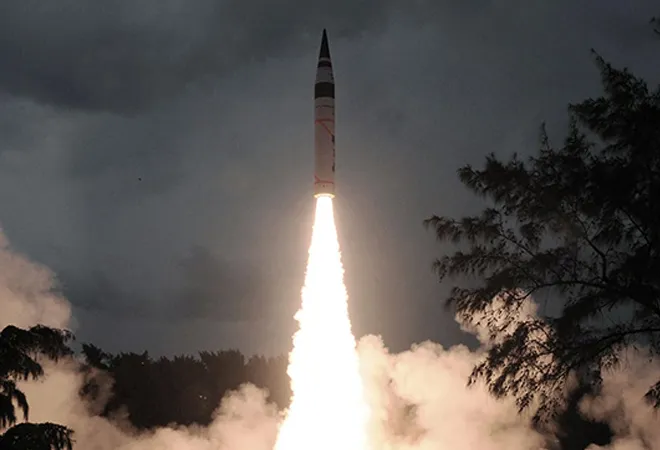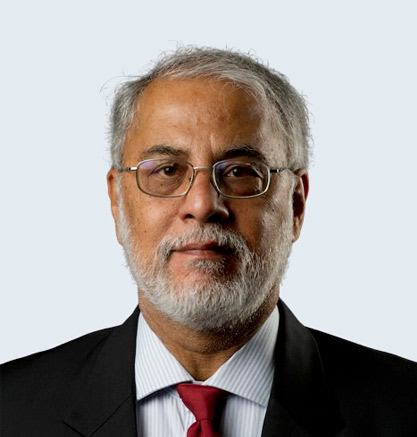-
CENTRES
Progammes & Centres
Location
With more nations building their nuclear arsenal, the Indo-Pacific is becoming a high-risk place.

The new Australia-UK-US (AUKUS) alliance is the latest warning of the looming threat of war in the Indo-Pacific region. In the middle of this month, we saw competing missile tests conducted by North and South Korea, there have been successive and deliberate intrusions into Taiwan’s Air Defense Identification Zone (ADIZ) by the People’s Liberation Army Air Force (PLAF), and, most recently, the Chinese have issued a veiled warning against India’s planned Agni-V missile test and have been spotted constructing hundreds of new silos to house their long-range nuclear armed missiles in Gansu and Inner Mongolia.
The hostility between the US and China is no longer constrained. Within a week of telling Xi Jinping over the telephone on September 9 that the US wanted to maintain the “guardrails” on the relationship to ensure “competition does not veer into conflict”, the United States sharply escalated the situation by entering into a new security alliance on September 15. Though China was not mentioned, it is clear that the US aim is to pose a challenge to Chinese naval activity, especially in the southern Pacific Ocean.
The US, Australia, the UK, New Zealand and Canada have a long-standing and dense secret alliance called the UKUSA Agreement. There is also an old non-binding and partially functional Australia-New Zealand-US (ANZUS) security pact, and an even looser Five Power Defence Arrangements (FPDA) linking Australia, New Zealand, UK along with Malaysia and Singapore. Though it has gained headlines because of the nuclear propelled submarine (boomer) decision, the new AUKUS is not simply an arms sales agreement, but a military pact whose full details have not been fully disclosed and whose longer-term implications are not yet clear.
In his announcement, Australian Prime Minister Scott Morrison declared that Australia “ has no plans to acquire nuclear weapons”. But as is evident from the sudden decision to get a “boomer”, such commitments need to be taken with a pinch of salt.
The Americans and British are not going to pretend to be scrupulous on this point. But there is one issue of concern. Unlike the VM-4 reactor for the Arihant, which uses uranium enriched at around 20 per cent to 30 per cent, modern US-UK reactors used highly enriched uranium at about 95 per cent, which is also ideal for making a nuclear weapon. It remains to be seen as to how the US-UK work the Australian deal to meet their own non-proliferation commitments.
Far off in another part of the Indo-Pacific, there has been the manufactured controversy over the first user trials of the Indian Agni V missile, expected on September 23. The missile, with a range of some 5,000 km, has already been tested several times earlier. This time around, the Chinese responded to the news by citing the UN Security Council Resolution 1172, issued after India’s 1998 nuclear weapons test. Foreign Ministry spokesman and “wolf warrior” Zhao Lijian noted that the 1998 resolution, which is still operative on paper, had called on India and Pakistan to “stop their nuclear weapons development programmes, to refrain from weaponisation … to cease development of ballistic missiles capable of delivering nuclear weapons…”
India has yet to decide on the design of its new SSN. It could well take off from the Arihant itself and upgrade its reactor. On the other hand, it may go in for a new single-hull design, or approach the French for help.
One thing is certain — with more nations coming up with nuclear-propelled and conventional submarines and new missiles, the Indo-Pacific is becoming a high-risk place. Old quarrels are getting nastier. There seem to be few signs that any of the parties — the US, China, North and South Korea, India, Australia and Japan — are willing to back off. All that can be said is that with two official nuclear powers, and two unofficial ones, the consequences of any conflict could be so destructive that they would change the future of the world.
This commentary originally appeared in The Quint.
The views expressed above belong to the author(s). ORF research and analyses now available on Telegram! Click here to access our curated content — blogs, longforms and interviews.

Manoj Joshi is a Distinguished Fellow at the ORF. He has been a journalist specialising on national and international politics and is a commentator and ...
Read More +